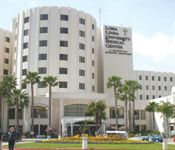Eight steps to reaching high performance
Like it or not, health-system pharmacies are under tremendous pressure to perform at a high level. Addressing patient safety concerns, improving outcomes, implementing state-of-the-art technology, and keeping drug costs down requires a juggling act that pharmacists must perform on a daily basis.

Last December, when McKesson Corp. unveiled its High Performance Pharmacy study and launched a related Web site, the health-system pharmacy community took notice. At its core, the study identifies best practices that define high performance within a health system. The goal is to have pharmacy managers adopt and use these performance indicators as a model to shape their own policies regarding patient safety, clinical quality, and financial performance.
"This will provide an actionable plan that will be interactive and allow a pharmacy to take that step toward improving their performance," said Chris Borr, senior director of health-system marketing for McKesson. With the Web site launch (http:// http://www.HighPerformancePharmacy.com/), McKesson expects to provide health-system pharmacists with easy access to the information contained in the study.
The high performance pharmacy initiative was born out of The Health Systems Pharmacy Executive Alliance, a collaboration of health system pharmacy leaders and McKesson employees who are dedicated to advancing hospital pharmacy's contributions to patient safety, clinical quality and financial performance.
Early adopters of the best practices outlined in McKesson's high-performance pharmacy study are already beginning to reap the rewards.
At Loma Linda University Medical Center in California, data from McKesson's high-performance pharmacy study were used in an initiative designed to improve IV pump safety. "High-performance pharmacy is a road map that directors of pharmacy can look at to evaluate where they are at their hospital," said Paul Norris, Pharm.D., executive director of pharmacy services. Norris explained that based on what a director of pharmacy or the administration wants to achieve at his or her facility, he or she can use [the data] as a benchmark. "It gives you a heads-up as to how much work, money, and effort it's going to take and what kind of return on investment you're going to get." Norris, who was a member of the executive alliance that helped craft McKesson's guidelines, said the high-performance pharmacy guidelines give pharmacists a tool that they didn't have before. The guidelines, he added, help pharmacists make crucial decisions regarding cost containment, patient safety, and use of technology.
Joe Ness, R.Ph., VP-ancillary and support services at Southwest Washington Medical Center, Vancouver, Wash., sees high-performance pharmacy complimenting ASHP's 2015 initiative. "I see high-performance pharmacy as a way to put some nuts and bolts into place and to measure your steps and progress toward what ultimately are aligned objectives with ASHP's 2015 initiative."
By using best practices outlined in the high-performance pharmacy study, Southwest Washington Medical Center has been able to improve inventory management and save more than $70,000. The hospital has also achieved an average rate of 53 prevented medication errors per 1,000 patient days. "We've integrated not only the 2015 initiative but this high-performance pharmacy-the dimensions and the goals and the benchmark measures that are in there as part of our department goal-setting," said Ness.
Designed to build on the eight dimensions of high performance, the McKesson study also identifies a set of more than 70 financial and clinical performance indicators that health-system pharmacies can use to gauge their progress in achieving higher performance for each of the eight dimensions. "It's all about getting from good to great," said Ness. "This is for organizations that are already doing a good job that really want to get to that great level."
Newsletter
Pharmacy practice is always changing. Stay ahead of the curve with the Drug Topics newsletter and get the latest drug information, industry trends, and patient care tips.